What's inside
What's inside
 Key Ingredients
Key Ingredients

No key ingredients
 Benefits
Benefits

 Concerns
Concerns

 Ingredients Side-by-side
Ingredients Side-by-side

Water
Skin ConditioningCetearyl Alcohol
EmollientBehentrimonium Chloride
PreservativeCetyl Alcohol
EmollientStearyl Alcohol
EmollientLimnanthes Alba Seed Oil
Skin ConditioningCaprylic/Capric Triglyceride
MaskingOlea Europaea Fruit Oil
MaskingPersea Gratissima Oil
Skin ConditioningCetyl Esters
EmollientGuar Hydroxypropyltrimonium Chloride
Skin ConditioningPotassium Sorbate
PreservativeCocoyl Hydrolyzed Quinoa Protein
Hydrolyzed Rice Protein
Skin ConditioningPanthenyl Hydroxypropyl Steardimonium Chloride
Brassica Campestris/Aleurites Fordi Oil Copolymer
Skin ConditioningCocos Nucifera Oil
MaskingRubus Idaeus Fruit Extract
AstringentPelargonium Graveolens Extract
MaskingChamomilla Recutita Flower Extract
MaskingAnanas Sativus Fruit Extract
Skin ConditioningCitric Acid
BufferingLinum Usitatissimum Seed Oil
PerfumingSodium Citrate
BufferingPhenoxyethanol
PreservativeEthylhexylglycerin
Skin ConditioningOryza Sativa Bran Oil
EmollientParfum
MaskingWater, Cetearyl Alcohol, Behentrimonium Chloride, Cetyl Alcohol, Stearyl Alcohol, Limnanthes Alba Seed Oil, Caprylic/Capric Triglyceride, Olea Europaea Fruit Oil, Persea Gratissima Oil, Cetyl Esters, Guar Hydroxypropyltrimonium Chloride, Potassium Sorbate, Cocoyl Hydrolyzed Quinoa Protein, Hydrolyzed Rice Protein, Panthenyl Hydroxypropyl Steardimonium Chloride, Brassica Campestris/Aleurites Fordi Oil Copolymer, Cocos Nucifera Oil, Rubus Idaeus Fruit Extract, Pelargonium Graveolens Extract, Chamomilla Recutita Flower Extract, Ananas Sativus Fruit Extract, Citric Acid, Linum Usitatissimum Seed Oil, Sodium Citrate, Phenoxyethanol, Ethylhexylglycerin, Oryza Sativa Bran Oil, Parfum
Alternatives
Ingredients Explained
These ingredients are found in both products.
Ingredients higher up in an ingredient list are typically present in a larger amount.
This ingredient is an emollient, solvent, and texture enhancer. It is considered a skin-softener by helping the skin prevent moisture loss.
It helps thicken a product's formula and makes it easier to spread by dissolving clumping compounds.
Caprylic Triglyceride is made by combining glycerin with coconut oil, forming a clear liquid.
While there is an assumption Caprylic Triglyceride can clog pores due to it being derived from coconut oil, there is no research supporting this.
Learn more about Caprylic/Capric TriglycerideOlea Europaea Fruit Oil is the fixed oil obtained from the ripe fruit of the Olive. In other words - olive oil.
The primary contents of olive oil are glycerides of the fatty acids linoleic, oleic and palmitic.
Olive oil also contains antioxidants such as Vitamin E. Antioxidants may help reduce signs of aging by fighting unstable free-radical molecules. It also contains Vitamins A (retinol), D, and K.
The squalene in olive oil makes it a great emollient. Emollients help soothe and soften your skin by trapping moisture in. This makes olive oil a great skin moisturizer.
Studies show olive oil to have antibacterial and antifungal properties in low concentrations. Another study found olive oil irritated sensitive oily skin. We always recommend speaking with a professional about using this ingredient in your routine.
Due to the fatty acid content, this ingredient may not be fungal-acne safe.
Learn more about Olea Europaea Fruit OilParfum is a catch-all term for an ingredient or more that is used to give a scent to products.
Also called "fragrance", this ingredient can be a blend of hundreds of chemicals or plant oils. This means every product with "fragrance" or "parfum" in the ingredients list is a different mixture.
For instance, Habanolide is a proprietary trade name for a specific aroma chemical. When used as a fragrance ingredient in cosmetics, most aroma chemicals fall under the broad labeling category of “FRAGRANCE” or “PARFUM” according to EU and US regulations.
The term 'parfum' or 'fragrance' is not regulated in many countries. In many cases, it is up to the brand to define this term.
For instance, many brands choose to label themselves as "fragrance-free" because they are not using synthetic fragrances. However, their products may still contain ingredients such as essential oils that are considered a fragrance by INCI standards.
One example is Calendula flower extract. Calendula is an essential oil that still imparts a scent or 'fragrance'.
Depending on the blend, the ingredients in the mixture can cause allergies and sensitivities on the skin. Some ingredients that are known EU allergens include linalool and citronellol.
Parfum can also be used to mask or cover an unpleasant scent.
The bottom line is: not all fragrances/parfum/ingredients are created equally. If you are worried about fragrances, we recommend taking a closer look at an ingredient. And of course, we always recommend speaking with a professional.
Learn more about Parfum